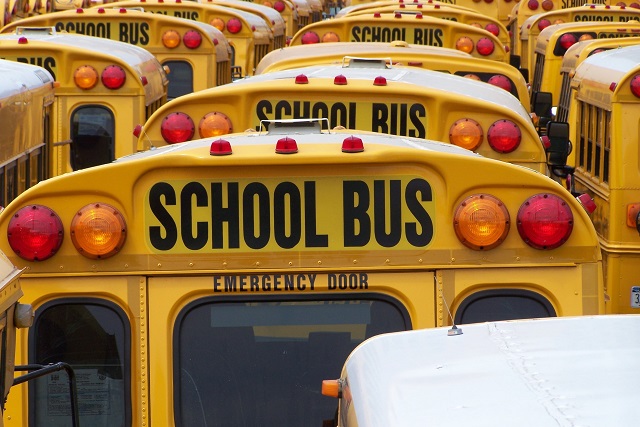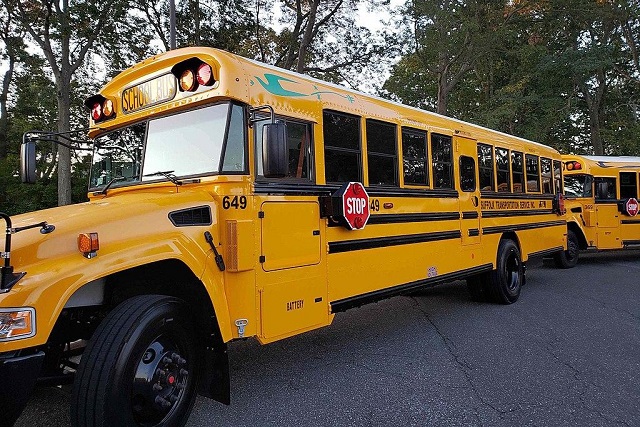
Electric school buses are experiencing rapid growth in the United States, with a nearly 10-fold increase in commitments by school districts and fleet operators in the past year. Thirty-eight states have now committed to procure more than 12,000 electric school buses.
In the first half of 2022, several states took important action to further the transition to clean school buses.
Most significantly, New York enacted a nation-leading commitment to achieve a fully zero-emission school bus fleet by 2035. Following in short order, three additional states passed similar fleet electrification targets, with one additional target still under consideration in California.
In addition to setting transition timelines, several states continued to appropriate dedicated funding for electric school buses, seeking to leverage the federal funds available through the new $5 billion EPA Clean School Bus Program, which will offer a series of funding opportunities over the next five years to cover costs associated with electric school bus fleet transitions, including bus replacements and charging infrastructure.
3 Big Wins for Electric School Buses in 2022 State Legislative Sessions
Governors and state legislators seeking to champion the equitable deployment of electric school buses have a range of policy options to support this transition. In enacted legislation so far this year, we have seen three big wins for kids and communities:
1) States are setting deadlines for fully electrifying school bus fleets.
In April 2022, New York made history as the first state in the nation to commit to electrifying its school bus fleet, passing legislation as part of the budget requiring all new school bus purchases to be zero emission by 2027 and all buses in operation to be zero emission by 2035. This commitment is especially notable because New York has one of the nation’s largest school bus fleets: approximately 47,000 vehicles, which currently run almost exclusively on polluting fossil fuels that are harmful to students, workers and communities.
The measure succeeded in large part due to the support of a broad coalition of public health, environmental, labor, equity and industry stakeholders, as well as continuous engagement with school districts, school bus operators and their representatives.
Critically, advocates were able to secure robust state funding to accompany the state’s ambitious transition target. As part of the final fiscal year 2023 budget, Governor Hochul and state lawmakers committed $500 million for electric school buses and incorporated this funding into a broader environmental bond act that will go before New York voters in November.
In addition to New York, three other states also set school bus fleet electrification targets so far this year. The varied approaches taken by these states highlight the multitude of factors for policymakers to consider as they plan to transition their fleets:
- In May 2022, Connecticut Governor Lamont signed SB4, which sets an earlier fleet electrification date of 2030 for school buses operating in environmental justice communities (as previously defined in state statute) and includes strong technical assistance provisions.
- In March 2022, Maryland passed SB528, which determined that all new school bus purchases and contracts statewide will be electric by 2025 (the earliest such date of targets passed this session) and established an electric school bus utility pilot program for up to $50 million per investor-owned utility in the state.
- In Maine, Governor Mills signed LD 1579 in May 2022, which requires that 75% of new school bus purchases and contracts must be zero emission by 2035, and creates an interagency working group that includes school districts and utilities to help with deployment.
A note to legislators: To be successful, all of these targets will need to be backed up with dedicated funding.

2) States continue to appropriate funds for electric school buses and are prioritizing equity.
State fleet electrification targets and the launch of the EPA’s $5 billion Clean School Bus Program are important and ground-breaking developments. But states are also continuing to launch new state grant programs and enhance existing ones. Continued state funding support for school bus electrification is critical, as EPA Clean School Bus Program funds are not guaranteed and will only cover a portion of a district’s fleet. In addition, many of the existing state programs rely on funds from the state mitigation trust established in 2017 following the Volkswagen settlement, which have largely been spent down.
It’s worth emphasizing that the EPA Clean School Bus program is awarding funds via a lottery and on a competitive basis. That is to say, there is not a set amount available for each state via a formula program. Additional state and local funds will be needed to cover the full costs of fleet transition.
Several states are creating new funding streams and furthering equity by prioritizing support for underserved communities. As part of a broader air quality package signed by Governor Polis in June 2022, Colorado created a new school bus electrification grant program with initial funding of $65 million. This program is notable for its equity-first approach. While some implementation details are still to be determined, the final law prioritizes investments based on a variety of equity metrics including income level, racial makeup, health impacts and air pollution burdens (including federal nonattainment areas), and more.
The bill also calls for robust interagency plans for technical assistance. Finally, the bill made an important distinction that diesel-to-electric conversions, or repowers, would be eligible for state funds from the grant program. Including repowers is an important step state programs can take to lower costs for school districts and reduce waste and delivery delays during a time of supply chain shortages. When combined with Colorado’s previous investment in school buses through Volkswagen settlement funds, this new program solidifies Colorado’s leadership as the state that, at the time of passage, had invested the most funding per capita to help school districts go electric. Colorado also outlined goals for electric school bus deployments with the May 2022 release of its Clean Trucking Strategy, which includes goals of 2,000 electric school buses on the road by 2027 and a full fleet transition by 2035.
New Jersey created a new grant program in June 2022 that allocates $45 million over a three-year period dedicated to school bus electrification and associated charging infrastructure. At least half of the funding each year must go toward low-income, urban or environmental justice communities.
Connecticut’s adjusted budget bill, passed in May 2022, established a new $20 million grant program to be designed specifically to maximize applications for federal funds by providing state matching grants for the purchase or lease of zero emission school buses and charging infrastructure. The grant program gives preference to applications that primarily serve environmental justice communities. These matching funds will provide a crucial bridge, especially if federal funds fall short of covering the full incremental cost of transitioning to a zero-emission fleet. The assistance provided to school districts to apply for federal funding will enable under-resourced districts to maximize their opportunities to win federal awards.
3) More states are creating a supportive policy environment for electric school buses.
A record number of states across the nation took action on electric school buses this year, some of which are highlighted below. The proposals often addressed critical but less visible areas of state jurisdiction over electric school buses – including clarifying state education funding terms and lease and contract provisions. Many passed with bipartisan support.
In Washington, HB1644 , passed in March 2022, permits local entities to deploy a fuller suite of actions to move forward with school bus electrification. This bill ensures that state appropriations for county-level transportation vehicle funds can be used for school district charging infrastructure, school bus fleet electrification feasibility plans, and for electric repowers and conversions.
West Virginia also made changes to its state transportation funding for school districts in HB4571, passed in March 2022, following GreenPower Motor’s announcement that it would build a new electric school bus manufacturing facility in Charleston. For costs incurred when operating alternative fuel vehicles, including electric school buses, the state will increase the regular transportation reimbursement for school districts by 10%. An additional 5% is provided for alternative vehicles manufactured in West Virginia. This bill demonstrates how school bus electrification can drive both cleaner rides for students and economic opportunities for states seeking to expand domestic manufacturing industries.
Indiana became the latest state to approve utility pilot programs for electric school buses with the passage of HB1221 in March 2022. Upon approval by the Indiana Utility Regulatory Commission (IURC), the pilot programs may be structured to deploy charging and make-ready infrastructure and provide various customer incentives to promote public use electric vehicles, such as electric school and transit buses, and their supply equipment.
In Mississippi, SB2887, passed in April 2022, adds electric vehicles to the forms of transportation that school districts may purchase, own and operate under state law. While SB2887 carries no other substantive provisions related to ESBs, it had Republican sponsorship and near-unanimous support.
Finally, in Idaho, S1319, passed in March 2022, extends the possible length of school bus contracts receiving funding under the federal Clean School Bus Program to 10 years from the previous five. The extension of school bus contracts allows for greater total cost of ownership savings to be realized, as the cost benefits of operating an electric vehicle — such as reduced maintenance and fuel costs — increase over the lifetime of the vehicle.
The Road Ahead for Electric School Buses in the US
The variety of bills passed so far in 2022 — from nation-leading fleet electrification targets to economic development and manufacturing support — show that there is no single policy solution in supporting state priorities on electric school buses. And in many of the passed bills, states used existing statutes that define and identify environmental justice communities and prioritized investments in these communities.
Now, state officials, advocates, school districts and others in these states must turn their focus toward thoughtful and equitable implementation of these programs, while other states move to adopt their own measures. The significant federal funds available through the five-year EPA Clean School Bus Program can keep this momentum growing through the coming years. States will play a key role in adding speed, strength and scale to this effort to provide all kids a clean commute to school.
The authors thank former WRI intern Noah Strand for his contributions tracking electric school bus legislation.
This article originally appeared on WRI’s Insights.
Katrina McLaughlin is Research Analyst II on the U.S. Energy team at World Resources Institute.
Navva Sedigh is the Policy and Financing Analyst for the Electric School Bus Initiative at World Resources Institute.





